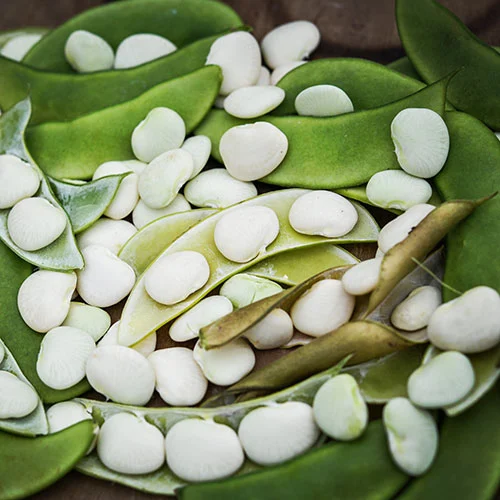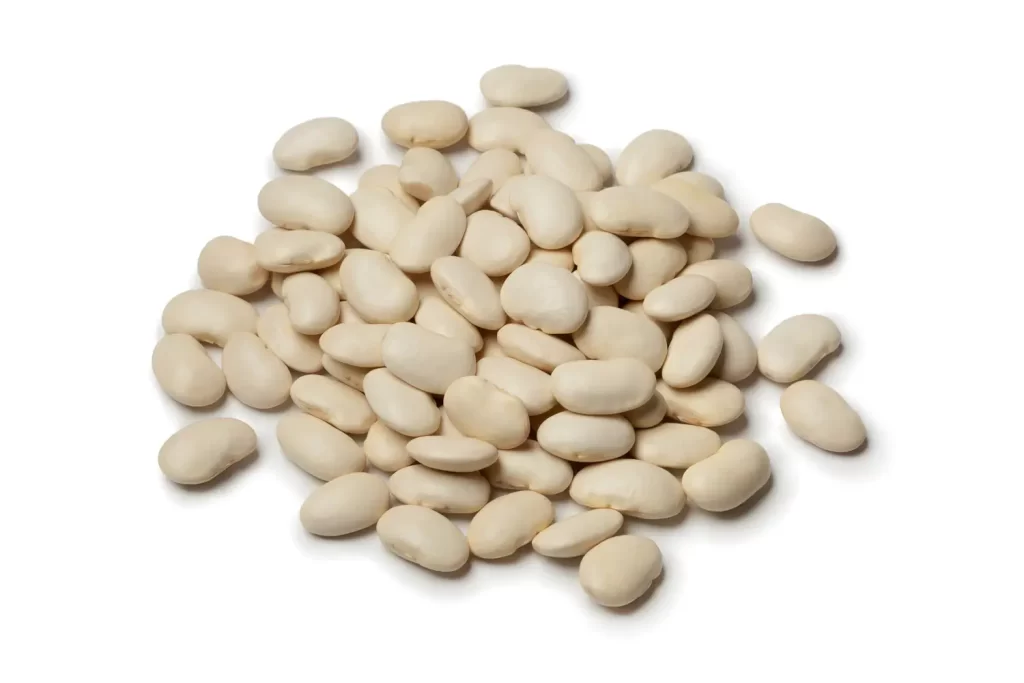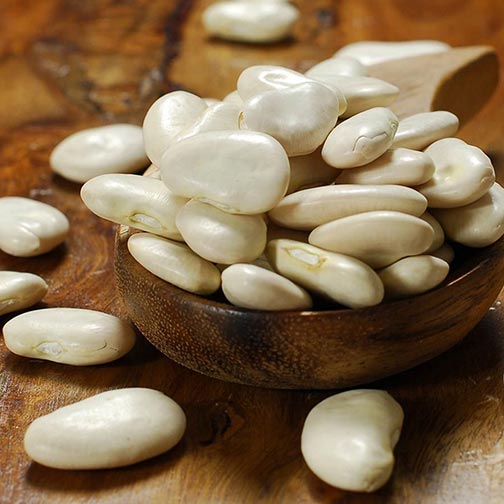Lima beans
Lima beans, also known as butter beans, are legumes that belong to the Fabaceae family. They are named after the city of Lima in Peru, but they have been cultivated in the Americas for thousands of years. Lima beans are valued for their creamy texture and mild flavor.
Here are some key points about Lima beans:
Varieties: There are different varieties of Lima beans, including the large-seeded Fordhook and King varieties, as well as the smaller baby Lima beans.
Nutritional Value: Lima beans are a good source of protein, dietary fiber, and various nutrients such as folate, manganese, potassium, and iron. They are low in fat and calories, making them a healthy addition to a balanced diet.
Preparation: Lima beans can be purchased fresh, frozen, or dried. Fresh Lima beans may be found in some markets, especially during the growing season. Dried Lima beans need to be soaked before cooking. They can be boiled, steamed, or included in soups, stews, and casseroles.
Health Benefits: Lima beans offer several health benefits. The fiber content can help with digestion and promote a feeling of fullness. The beans also provide complex carbohydrates, which contribute to sustained energy levels.
Culinary Uses: Lima beans have a versatile flavor that pairs well with various ingredients. They are commonly used in soups, stews, and succotash (a Native American dish typically consisting of lima beans and corn). Additionally, they can be mashed and used as a spread or added to salads.
Cautions: Lima beans, like other legumes, contain compounds that can interfere with the absorption of minerals. Soaking and cooking them properly can help reduce these compounds. Additionally, some people may be allergic to legumes, so it’s essential to be cautious if you have known allergies.
Lima beans are a nutritious and delicious addition to a well-rounded diet, providing a good source of plant-based protein and other essential nutrients.
In Urdu, lima beans are known as “لائما بینز” (pronounced as “Lima Beans”). Here’s a simple recipe for preparing seasoned lima beans:
Lima Beans Recipe
Ingredients:
1 cup dried lima beans (soaked overnight and drained)
2 tablespoons olive oil
1 onion, finely chopped
2 cloves garlic, minced
1 teaspoon cumin powder
1 teaspoon coriander powder
1/2 teaspoon red chili powder (adjust to taste)
Salt to taste
Fresh coriander leaves for garnish
Instructions:
Soak the Lima Beans: Rinse the dried lima beans and soak them overnight in enough water to cover them.
Cook the Lima Beans: Drain the soaked lima beans, place them in a pot, and cover with fresh water. Bring to a boil and then simmer until the beans are tender. This may take about 30-45 minutes. Drain any excess water.
Sauté Onions and Garlic: In a separate pan, heat olive oil over medium heat. Add chopped onions and sauté until they become translucent. Add minced garlic and continue cooking for another minute.
Season the Beans: Add the cooked lima beans to the pan with onions and garlic. Stir in cumin powder, coriander powder, red chili powder, and salt. Mix well to coat the beans evenly with the spices.
Cook and Garnish: Allow the seasoned lima beans to cook for an additional 5-7 minutes, stirring occasionally. Taste and adjust the seasoning if necessary. Garnish with fresh coriander leaves.
Serve: Serve the seasoned lima beans as a side dish or as part of a main course. They can be enjoyed with rice, bread, or on their own.
Lima Beans Protein:
Lima beans are a good source of plant-based protein. One cup of cooked lima beans provides around 15 grams of protein, making them a nutritious option for those looking to incorporate more plant proteins into their diet.
Feel free to customize the recipe according to your taste preferences, adding ingredients like tomatoes, bell peppers, or lemon juice for extra flavor. Enjoy your seasoned lima beans!
Seasoning Lima Beans:
The seasoning for Lima beans can vary based on personal taste preferences. Common seasonings include cumin, coriander, garlic, and chili powder. You can experiment with herbs like thyme or oregano for added flavor. Don’t forget to adjust the salt and spice levels according to your liking.
Feel free to customize this recipe and adjust the seasonings to suit your taste. Enjoy your delicious and nutritious Lima beans!
Lima Beans Side Effects:
Lima beans are generally safe for most people when consumed as part of a balanced diet. However, like many foods, they may cause some side effects in certain individuals:
Flatulence: Lima beans, like other legumes, contain complex carbohydrates that can cause gas and bloating in some people. Soaking the beans before cooking and gradually increasing your intake may help reduce these effects.
Antinutrients: Lima beans contain compounds such as phytic acid and lectins, which are considered antinutrients. These compounds may interfere with the absorption of minerals. Proper soaking and cooking can help mitigate the effects of these antinutrients.
Allergic Reactions: In rare cases, individuals may be allergic to legumes, including Lima beans. If you experience symptoms such as itching, swelling, or difficulty breathing after consuming Lima beans, seek medical attention.
Lima Beans Benefits for Weight Loss:
Lima beans can be beneficial for weight loss due to several reasons:
High Fiber Content: Lima beans are rich in dietary fiber, which can contribute to a feeling of fullness and help control appetite.
Low in Calories and Fat: Lima beans are relatively low in calories and fat, making them a nutritious and satisfying option for those looking to manage their weight.
Protein Source: The protein content in Lima beans can also contribute to a balanced diet, helping maintain muscle mass during weight loss.
Lima Beans Calories:
The calorie content of Lima beans can vary depending on whether they are fresh, frozen, canned, or dried. On average, one cup of cooked Lima beans contains approximately 200-220 calories. It’s important to note that the calorie count may change based on how the beans are prepared and any additional ingredients used in recipes.
Lima Beans Scientific Name and Family:
The scientific name for Lima beans is Phaseolus lunatus. They belong to the family Fabaceae. The Fabaceae family is also known as the legume, pea, or bean family, and it includes a wide variety of plants with economic and ecological importance, such as beans, peas, lentils, and peanuts.
Lima Bean Uses:
Lima beans have versatile culinary applications and can be used in various ways:
Soups and Stews: Lima beans are commonly used in soups and stews to add a creamy texture and mild flavor.
Side Dishes: They can be served as a side dish, either on their own or seasoned with herbs and spices.
Casseroles: Lima beans can be included in casseroles, providing a nutritious and hearty element to the dish.
Salads: Lima beans can be a nutritious addition to salads, providing protein and fiber.
Mashed or Pureed: Cooked Lima beans can be mashed or pureed and used as a spread or dip.
Succotash: A traditional Native American dish, succotash typically includes lima beans and corn.
Lima Beans Benefits:
Nutrient-Rich: Lima beans are a good source of protein, dietary fiber, folate, manganese, potassium, and iron.
Heart Health: The fiber and potassium content in Lima beans may contribute to heart health by helping maintain healthy blood pressure levels and reducing cholesterol.
Weight Management: The high fiber content can aid in weight management by promoting a feeling of fullness.
Digestive Health: The fiber in Lima beans supports digestive health by preventing constipation and promoting regular bowel movements.
Lima Bean Origin:
Lima beans are believed to have originated in South America, particularly in the Andes region. They have been cultivated for thousands of years and were a staple in the diet of ancient civilizations in the Americas. The beans were introduced to Europe by Spanish explorers in the 16th century and later spread to other parts of the world.

Lima Bean Size:
The size of Lima beans can vary based on the variety. There are both large-seeded and small-seeded varieties of Lima beans. The large-seeded varieties, such as Fordhook and King, have relatively bigger beans, while the baby Lima beans are smaller in size. The size can also be influenced by factors such as growing conditions and cultivation methods. When cooked, Lima beans typically become soft and have a creamy texture.
Lima Bean Seeds:
Lima bean seeds are the edible part of the Lima bean plant. These seeds are contained within the pods, and they are what is commonly consumed as a food source. Lima bean seeds can be large or small, depending on the variety. The seeds are typically harvested once the pods have matured, and they can be used in various culinary applications after proper preparation.
Lima Beans Vitamins:
Lima beans are a good source of several vitamins, including:
Folate (Vitamin B9): Folate is essential for cell division and DNA synthesis. It is particularly important during periods of rapid growth, such as pregnancy.
Vitamin C: Lima beans contain vitamin C, an antioxidant that supports the immune system, helps the body absorb iron, and promotes healthy skin.
Vitamin K: Lima beans provide vitamin K, which plays a role in blood clotting and bone health.
Lima Beans Nutrition:
Lima beans are nutritionally rich and provide a variety of essential nutrients per serving, including:
Protein: Lima beans are a good plant-based source of protein, important for muscle growth and repair.
Dietary Fiber: The high fiber content in Lima beans supports digestive health and helps maintain a feeling of fullness.
Complex Carbohydrates: Lima beans contain complex carbohydrates, providing a steady release of energy.
Minerals: Lima beans are a good source of minerals such as manganese, potassium, and iron.
Low in Fat: Lima beans are relatively low in fat, making them a healthy option for those watching their fat intake.
Lima Beans Health Benefits:
Heart Health: The fiber and potassium in Lima beans can contribute to heart health by helping regulate blood pressure and cholesterol levels.
Weight Management: The combination of protein and fiber in Lima beans can aid in weight management by promoting satiety and reducing overall calorie intake.
Blood Sugar Regulation: The fiber content in Lima beans may help regulate blood sugar levels by slowing the absorption of sugars.
Digestive Health: The dietary fiber in Lima beans supports digestive health by preventing constipation and promoting a healthy gut.
Nutrient Boost: Lima beans provide a range of essential nutrients, contributing to overall health and well-being.
As with any food, it’s important to incorporate Lima beans into a balanced and varied diet to maximize their nutritional benefits. If you have specific health concerns or dietary restrictions, it’s advisable to consult with a healthcare professional or a registered dietitian.
Lima Beans vs. Butter Beans:
Lima beans and butter beans are terms that are often used interchangeably, but there can be some regional and cultural variations in their usage. In the United States, the term “butter beans” is commonly used to refer to large, flat Lima beans. Both Lima beans and butter beans belong to the same species (Phaseolus lunatus), and the names are sometimes used interchangeably based on local preferences.
Lima Beans vs. Broad Beans:
Lima beans and broad beans (also known as fava beans) are distinct varieties with differences in appearance, taste, and texture:
Appearance: Lima beans are generally smaller and flat, while broad beans are larger and have a more rounded shape.
Taste: Lima beans have a mild, buttery flavor, while broad beans have a slightly nutty taste. The taste can vary based on the specific variety and how they are prepared.
Texture: Lima beans tend to have a creamy texture when cooked, while broad beans have a firmer texture.
Culinary Uses: Lima beans are often used in a variety of dishes, including soups, stews, and casseroles. Broad beans are commonly used in Mediterranean and Middle Eastern cuisines, and they are often enjoyed on their own, in salads, or as a side dish.

Lima Beans Advantages and Disadvantages:
Advantages:
Nutrient-Rich: Lima beans are a good source of protein, dietary fiber, vitamins, and minerals.
Versatility: Lima beans can be used in a variety of dishes, making them a versatile ingredient in the kitchen.
Plant-Based Protein: They are an excellent plant-based protein source, suitable for vegetarians and vegans.
Digestive Health: The fiber in Lima beans supports digestive health by promoting regular bowel movements and preventing constipation.
Disadvantages:
Flatulence: Lima beans, like other legumes, can cause gas and bloating in some individuals due to their complex carbohydrates. Proper soaking and cooking can help reduce this issue.
Antinutrients: Lima beans contain antinutrients such as phytic acid and lectins, which may interfere with mineral absorption. Soaking and cooking can help mitigate these effects.
Allergic Reactions: In rare cases, individuals may be allergic to legumes, including Lima beans. Allergic reactions can range from mild to severe, and medical attention should be sought if symptoms occur.
Preparation Time: Dried Lima beans require soaking and cooking, which can be time-consuming compared to using canned or frozen beans.
It’s important to note that the advantages and disadvantages can vary from person to person based on individual dietary needs, preferences, and tolerances. If you have specific health concerns or dietary restrictions, it’s advisable to consult with a healthcare professional or a registered dietitian.
Lima beans nutritional value per 100g nutrition data
The nutritional value of Lima beans (per 100 grams, boiled without salt) is approximately as follows:
Calories: 115 kcal
Protein: 7.8 g
Carbohydrates: 20.2 g
Dietary Fiber: 6.2 g
Sugars: 1.4 g
Fat: 0.4 g
Saturated Fat: 0.1 g
Monounsaturated Fat: 0.1 g
Polyunsaturated Fat: 0.2 g
Vitamins and Minerals:
Folate (Vitamin B9): 42 mcg (11% of the Daily Value)
Vitamin C: 1.8 mg (3% of the Daily Value)
Vitamin K: 2.8 mcg (4% of the Daily Value)
Thiamine (Vitamin B1): 0.2 mg (14% of the Daily Value)
Riboflavin (Vitamin B2): 0.1 mg (5% of the Daily Value)
Niacin (Vitamin B3): 0.5 mg (3% of the Daily Value)
Vitamin B6: 0.1 mg (6% of the Daily Value)
Pantothenic Acid (Vitamin B5): 0.3 mg (3% of the Daily Value)
Calcium: 13 mg (1% of the Daily Value)
Iron: 1.8 mg (10% of the Daily Value)
Magnesium: 25 mg (6% of the Daily Value)
Phosphorus: 54 mg (8% of the Daily Value)
Potassium: 325 mg (9% of the Daily Value)
Sodium: 5 mg (0% of the Daily Value)
Zinc: 0.5 mg (4% of the Daily Value)
Manganese: 0.5 mg (24% of the Daily Value)
Copper: 0.2 mg (8% of the Daily Value)
Lima Beans: Good for You
Lima beans are a nutritious and healthful food choice for several reasons:
Rich in Protein: Lima beans provide a good source of plant-based protein, making them a valuable addition to vegetarian and vegan diets.
High in Dietary Fiber: The high fiber content supports digestive health, helps regulate blood sugar levels, and contributes to a feeling of fullness.
Low in Fat: Lima beans are low in fat, particularly saturated fat, making them a heart-healthy food option.
Vitamins and Minerals: Lima beans contain various vitamins and minerals, including folate, iron, potassium, and manganese, which play essential roles in overall health.
Nutrient Density: Lima beans offer a range of nutrients with relatively few calories, making them a nutrient-dense food.
Incorporating Lima beans into a balanced and varied diet can contribute to meeting daily nutrient requirements and promoting overall well-being. It’s essential to consider individual dietary needs and preferences when planning meals.

